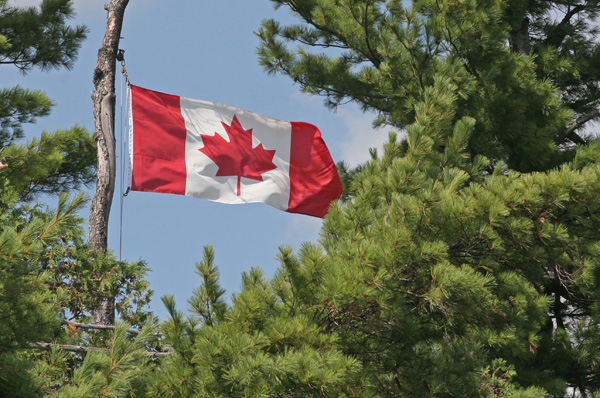Canada and the Rideau Canal
by
Ken W. Watson
Note: This article first appeared in the Spring/Summer 2017 edition of Rideau Reflections, the newsletter of the Friends of the Rideau (www.rideaufriends.com).
 |
Our Flag Among the Pines
Our flag flies proudly among the tall pines on Newboro Lake (photo by: Ken W. Watson)
|
This year, as Canada celebrates its 150th birthday, the
Rideau Canal enters its 186th year of operation. It’s a time
to both look back and to look forward at what the Rideau
Canal means to Canada.
We are a young nation, continuing to evolve. As with
all nations, our Canadian culture and identity is rooted in
our past. There are very few things that we can look at
today that directly speak to that evolution into
nationhood. The Rideau Canal is an element from our
past that operates today much as it did when first built.
It’s not a diorama in a museum, it’s the real deal, and it
speaks directly to our journey into becoming an
independent nation.
The Rideau is first and foremost a waterway, one that
has seen continuous use by humans since shortly after
the glaciers retreated and the Champlain Sea drained
about 10,000 years ago. The lakes and rivers of the Rideau
were attractive fishing and hunting grounds, we have
direct archaeological evidence of humans on the Rideau
dating back at least 8,000 years.
By the time of European colonization of North
America, the Rideau was both a significant native
summer hunting and fishing area, and a travelway
between the Ottawa and St. Lawrence rivers. A few
physical elements of that travelway still exist on the
Rideau today, such as portions of the old native portage
around what was formerly the extensive rapids at Jones
Falls.
Rapids along the Rideau provided power for
European technology; sawmills and grist mills. The
King’s Mills at Cataraqui Falls, built in 1784, were the
second saw and grist mills built in Ontario. Those
government mills were followed by entrepreneurs
bringing mill irons into the wilderness and setting up
their own mills at places such as Merrickville and
Morton. Settlers, United Empire Loyalists from the U.S.
and immigrants from the British Isles and Europe, were
arriving in every increasing numbers. The Rideau region
was turning into a frontier.
War with the recently formed United States, in 1812-
14, sparked a military need for a safe supply route to the
naval base at Kingston, which meant a canal to allow the
passage of larger boats. The military elements of the
Rideau Canal, the blockhouses and defensible
lockmaster’s houses that we can see today, speak directly
to our very rocky early relationship with the U.S.
The Rideau Canal played a significant role in shaping
the demographics of Ontario with thousands of loyal
British settlers travelling into then Upper Canada via the
Rideau Canal in the 1830s and 40s. And of course it was
directly responsible for the founding of Bytown, later
named Ottawa. In 1857 when Queen Victoria was asked
to choose the capital for the Province of Canada, she
picked Ottawa. Of the several reasons for this decision,
the Rideau Canal was a major factor, since it provided a
direct waterway connection to the new capital from both
the former Upper and Lower Canadas.
The commercial use of the Rideau, thousands of
barges travelling up and down every year, provided the
basis for community development – products could be
easily shipped to markets far and wide. We even see
rocks from the Rideau (apatite), barged to Kingston and
then down the St. Lawrence to Montreal and shipped to
England for use as fertilizer.
As commercial use waned in the late 1800s, the Rideau
was transitioning into a recreational waterway. Summer
homes and cottages were starting to be built on Rideau
lakes by the late 1870s. Canadians were just starting to
have leisure time available to them and were taking
advantage of all the wonderful outdoor activities the
Rideau could provide. We were again being invaded by
Americans, but this time as tourists, with resorts being
built on the Rideau to accommodate them. The evolution
of communities along the Rideau reflected this change in
usage.
When Canada celebrated its 100th birthday in 1967
there was much reflection on our past and a recognition
of the significant contribution made to our nation by the
Rideau Canal. That put machinery in motion that directly
led to the transfer of the Rideau Canal to Parks Canada in
1972, due to the heritage value it represented to Canada
and the need to protect and present that heritage.
Now in the 21st century, in our age of virtual
communication and increasing urbanization, the Rideau
Canal serves as a physical reminder of the early
development of our nation – you can step into the past at
any lockstation, see and touch those elements that helped
shape what we are today.
The Rideau Canal remains relevant to Canada on
many levels, from its continued significant economic
contribution to the communities in the Rideau Corridor
to its authenticity as a heritage site, one with “universal
values” (our UNESCO World Heritage Site designation)
which speaks directly to the many stories of our past and
our development as the nation of Canada.
I’ll add some wonderful words written by Sheila
Fraser, Canada’s former Auditor General, about
Canada’s National Historic sites, including the Rideau
Canal, and why we should care about them.
“These places recall the lives and history of the
men and women who built this country, and they
foster awareness of how Canadian society
evolved. They help us to better understand the
present and prepare for the future. They
contribute in important ways to Canadians' sense
of belonging to their community.”
The Rideau Canal, if properly preserved and
presented, will continue to remind us of our rich past as
we move into Canada’s bright future.
-Ken W. Watson
|